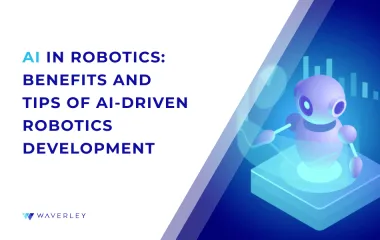AI Strategy for Your Business: From Concept to Implementation
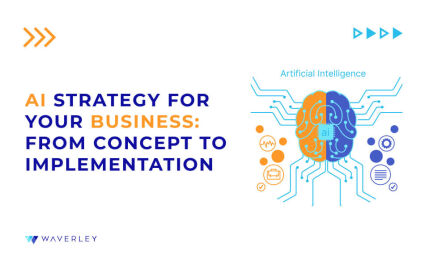
Contents
Generative AI has become incredibly popular nowadays. It’s not surprising that many organizations are testing ways to use artificial intelligence in their business. Multiple organizations already have extensive experience and success in deploying AI techniques.
The AI and ML technologies can significantly streamline the automation of manual repetitive tasks traditionally performed by humans, resulting in multiple benefits for businesses. AI is impacting nearly every industry, from manufacturing to hospitality, healthcare, and finance, etc. As organizations increase their use of AI development services within their operations, they’re reaping tangible benefits that are expected to deliver significant financial value.
According to research conducted by the firm Frost & Sullivan’s Global State of AI, 2023 87% of organizations believe AI and machine learning will help them grow revenue, boost operational efficiency, and improve customer experiences.
Here we can see how drastically the number of artificial intelligence tool users increased worldwide.
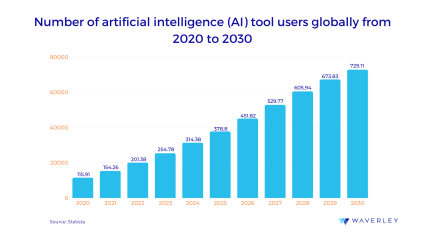
In this article, we will guide you through the process of implementing a successful AI strategy into your business and overcoming the possible challenges on your way.
Understanding the AI Strategy
Before you’re faced with the dilemma of the right steps for the AI integration process, you need to understand what AI strategy is and what is the importance of it.
According to McKinsey’s 2023 global survey on GenAI, about one-third of business leaders responded that they have adopted the technology for at least one functional area, including product development, manufacturing, supply chains, marketing and sales, service operations, corporate finance, and human resources. This means that about 60% of organizations that claim to have adopted AI are using generative AI.
So what is an artificial intelligence strategy? It is a plan for integrating AI into an organization so that it aligns with and supports the goals of the business. A successful AI strategy should act as a roadmap for this plan. Depending on the organization’s goals, the AI strategy might outline the steps to effectively use AI to extract deeper insights from data, enhance efficiency, and build a better delivery process.
A well-planned AI strategy should also guide the tech infrastructure, ensuring that the business is equipped with the hardware, software, and other resources needed for effective AI implementation. Since technology evolves so fast, the strategy should allow the organization to adapt to new tools, frameworks, and shifts in the industry. Ethical considerations such as bias, transparency, and regulatory concerns should also be addressed to support responsible deployment.
Benefits from the AI Implementation
An AI strategy outlines the steps that will help your AI projects smoothly transform ideas into impactful solutions. A well-designed strategy will provide a clear plan for managing, analyzing, and leveraging data for AI initiatives. It will also determine the talent the organization needs to develop, attract, or retain with relevant skills in data science, ML, business intelligence services, AI development, etc. It will also guide the procurement of the necessary hardware, software, and cloud computing resources to ensure effective AI implementation.
Here are a few of the possible benefits that AI can bring to your organization.
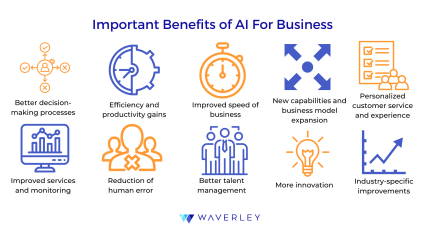
Better Decision-Making Process
Using AI to gain insights from the collected data helps to enhance the decision-making process. It’s usually referred to as “data-driven decisions.” As organizations embrace AI-driven data processing, they’re finding that they do indeed make better, more accurate decisions instead of the ones based on individual ideas or instincts.
Efficiency and Productivity Gains
There are two big benefits that organizations are gaining from the AI. For example, Adnan Masood, chief AI architect at UST, lets organizations handle tasks at a volume and velocity that’s simply not possible for humans to match. Also, AI technologies remove time-consuming manual tasks from workers. Therefore, we’ve got a productivity gain that lets workers focus on higher-level tasks.
Improved Speed of Business
AI significantly enables shorter cycles and cuts the time it takes to move from one stage to the next, facilitating more immediate ROI. For example, Seth Early (The AI-Powered Enterprise) claims that businesses move fast in this digital age, and AI helps them move even faster.
Personalized Customer Service and Experience
The most visible example of personalized customer service and experience is streaming services, such as Netflix. Retailers use intelligent systems to study buying patterns, individual consumer data and larger data sets to determine what each customer prefers at any given time to suit their personal style, interests, and needs. AI analyzes and learns from data to create highly personalized and customized experiences and services.
Improved Services and Monitoring
AI can use information gathered by devices on factory equipment to identify problems and predict the needed maintenance. This prevents disruptive breakdowns and costly repair work. AI’s monitoring capabilities can be effective in other areas, such as in enterprise cybersecurity operations where large amounts of data need to be analyzed and understood to identify potential threats. This means that AI’s capacity to take in and process massive amounts of data in real-time helps organizations implement near-instantaneous monitoring capabilities to be alert to issues and take measures promptly.
More Innovation
AI technologies help businesses use different tools more creatively. For example, with ChatGPT integration into your workflow, you can use AI to support R&D activities, such as in the healthcare space for drug discovery work and the consumer product goods sector for new product creation.
Revenue Growth
All implementations into your business should lead to automation of the processes and cost reduction, therefore the revenue will increase.
The latest annual McKinsey Global Survey on the current state of AI confirms the explosive growth of generative AI (gen AI) tools.
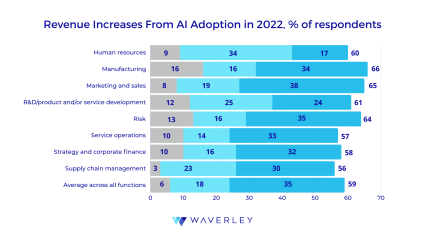
The 4 AI Strategy Pillars
Implementing a successful AI strategy requires to have a certain foundation. Let’s discuss what this foundation is.
1. Data Governance and Management
Governance and management help to establish powerful data frameworks and implement effective data management practices to ensure the quality, integrity, and security of data used for AI applications.
2. Technology and Infrastructure
Building scalable and flexible technology infrastructure capable of supporting AI initiatives is very critical to the successful implementation of AI strategies. Infrastructure also includes data storage, computing resources, and integration with existing systems.
3. Talent and Skills Development
AI strategies implemented in your business will help you invest in acquiring and developing AI talent with the necessary skills and expertise to develop, deploy, and maintain AI solutions effectively.
4. Ethics, Security, and Compliance
Generative AI is quite a new technology so it’s very important to stay informed about relevant regulations and standards governing AI usage in certain industries and ensure compliance with legal and regulatory requirements related to data privacy, security, and ethics. It’s also advised to prioritize ethical considerations in AI development and deployment, ensuring fairness, transparency, accountability, and privacy protection in all AI-driven processes and decisions.
Decide How to Measure the Success of AI
To measure the success of any project business KPIs (key performance indicators) are commonly used. However, what is a reliable KPI for AI? Reliable KPIs are measurable and transferable. So they can be directly recorded and then used indirectly to inform other metrics. In healthcare, for example, the speed and precision of a model’s clinical diagnosis could be measured as direct metrics, which could then influence an indirect metric like patient satisfaction.
For example, KPIs could be used to gauge the performance and ROI of several business initiatives. Similar to other projects, the KPIs your organization measures for AI should be based on your goals and overall automation strategy.
KPIs are frequently set to measure factors like data quality or security. Some may also track a hallmark of Trusted AI, like privacy (with a metric like location entropy) or fairness (with proportional parity).
Commonly used KPIs for AI include:
- Mean time to repair (MTTR). Measures the duration of error repair in an AI.
- Mean absolute error (MAE). Determines the average difference of predictions made by a regression model to the true value.
- First contact resolution rate (FCRR). Reveals the percentage of problems solved via basic support.
- True or false positive rate (T/FPR). A measure of fairness that helps determine the sensitivity and specificity of predicted classifications.
Ways To Implement AI In Your Business Strategy
There are many ways/approaches to integrate AI into your business strategy. In any case, the first step is to identify areas of your business that could benefit from AI implementation. It may include tasks that are repetitive or time-consuming, such as data analysis or customer service. It could also include business aspects where precision and speed are critical, such as manufacturing or financial services. Here is the universal guide.
1. Opportunity Identification
Identifying opportunities to integrate AI into your business strategy is a critical step toward leveraging its potential effectively. It is needed here to understand business goals and challenges, evaluate current processes, and explore industry trends, which is very important to integrate only innovative technologies.
2. Conducting Assessments
Conducting assessments is crucial for ensuring the successful integration of AI into your business strategy. Business owners should consider certain factors during this stage. We recommend determining what aspects of your business strategy and operations you want to evaluate concerning AI integration. Also, assess the current state of your organization’s readiness for AI integration. Conduct a risk assessment to identify potential risks and challenges associated with AI integration. Or evaluate the available AI technologies, tools, and platforms to determine which ones best align with your business goals and requirements.
3. Customized AI Solutions
Customized AI solutions tailored to your business strategy can provide significant competitive advantages and address specific challenges within your organization. For example, using AI-powered robots, smart assistants, personalized applications in the healthcare industry, and self-driving vehicles.
4. Collaboration with AI Experts
Collaborating with AI experts is essential for effectively integrating AI into your business strategy. Partnership with external organizations if needed has been a proven strategy for companies seeking mutual benefits in today’s highly competitive business environment. However, with the rise of technology, particularly artificial intelligence (AI), such partnerships can now be taken to the next level. For example, AI-powered personalized training, AI-powered partner matching, or AI-powered co-branded/multi-branded training.
5. Incremental Integration
Incremental integration of AI into your business strategy involves gradually implementing AI technologies and solutions in a phased approach. Businesses can achieve this by detailed planning, identifying low-risk cases, iterative implementation, and adapting to changing needs.
6. Enhancing Customer Experiences
Enhancing customer experiences through AI in your business strategy involves leveraging artificial intelligence technologies to personalize interactions, streamline processes, and provide proactive support. For example, product recommendation systems (Amazon), predictive analytics (Starbucks app), virtual assistant applications (Sephora app), etc.
7. Optimizing Operations
AI in your business strategy involves leveraging artificial intelligence technologies to streamline processes, improve efficiency, and drive cost savings.
8. Implementation of AI in products/services
Implementing AI in a products/services business strategy involves integrating artificial intelligence technologies into various aspects of your offerings, operations, and customer interactions. AI-powered products can be integrated into marketing, sales, operations, customer service, and CRM systems.
9. Employee Training and Upskilling
Employee training and upskilling in AI are essential for successfully integrating artificial intelligence technologies into your business strategy. For example, an MIT study showed that the productivity of workers who used ChatGPT increased by 37%.
10. Continuous Evaluation and Adaptation
Continuous evaluation and adaptation of AI in your business strategy is essential to ensure that AI initiatives remain aligned with business goals, deliver value, and stay responsive to changing market dynamics.
AI Implementation Strategy: How Can Companies Select the Right AI Model?
Here are some tips for choosing the right AI Model for your business:
- Select the right data type
Different AI models excel at handling specific types of data, such as images, text, or time-series information. Identify the nature of your data to determine which model is the most suitable for your project. - Evaluate the complexity of the problem
Evaluate the complexity of the problem you’re trying to solve. Some tasks may be well-suited to pre-trained models, while others require custom-built solutions. Tailor your choice to match the intricacy of your specific problem. - Assess the availability of labeled data for your project
Deep learning models often require a substantial amount of labeled data for effective training. Assess the availability of labeled data for your project and consider techniques like transfer learning if data is limited. - Consider the available resources
Consider the computational resources available to your organization. Large models like GPT-3 demand significant computing power, which may not be feasible for all companies. Ensure that your infrastructure can support the computational requirements of the chosen model. - Consider the level of interpretability required for your model/project
Think about the level of interpretability required for your model, especially in domains like healthcare or finance where transparency is crucial for regulatory compliance. Choose models that align with your interpretability needs and provide the necessary level of transparency.
What Should be the AI Implementation Plan?
To successfully implement AI in your business, begin by defining clear objectives aligned with your strategic goals. Identify the specific challenges AI can address, such as enhancing customer experiences or optimizing supply chain management.
Next, assess your data quality and availability, as AI relies on robust data. Ensure your data is accurate, relevant, and comprehensive. If necessary, invest in data cleaning and preprocessing to improve its quality.
Select the appropriate AI models that align with your objectives and data type. Train these models using your prepared data, and integrate them seamlessly into your existing systems and workflows.
Prioritize ethical considerations to ensure fairness, transparency, and lack of bias in AI systems. Thoroughly test and validate your AI models, and provide training for your staff to effectively use the new AI tools.
Plan for scalability and ongoing monitoring while staying compliant with data privacy regulations. Continuously measure ROI and the impact of AI on your business objectives, making necessary adjustments along the way.
Consider partnering with AI experts or service providers to streamline the implementation process. With a well-structured plan, AI can transform your business operations, decision-making, and customer experiences, driving growth and innovation.
You are ready to create your own AI implementation strategy. What’s next?
Implementing AI is a complex process that requires careful planning and consideration. Organizations must ensure that their data is of high quality, define the problem they want to solve, select the right AI model, integrate the tool within the existing system, and consider ethical implications. By considering these key factors, organizations can create a successful AI implementation strategy and reap the benefits of AI.
That said, the implementation of AI in business can be a daunting task when done alone and without proper guidance. However, there’s a simple solution. Implementing AI in business can be simplified by partnering with a well-established, capable, and experienced partner like Waverley Software.
Implementation Roadmap
An AI business roadmap is a strategic plan that outlines how your organization will incorporate AI technologies into its operations to achieve specific business objectives. Also, an effective AI roadmap helps in creating a clear path to meet your strategic goals while driving big business impact and ROI.
- Assessment and Preparation
You should begin by assessing your current business processes and identifying where AI could make a significant impact. Consider how AI can streamline operations, enhance customer experiences, or even create entirely new revenue streams. In the tech world, we can call this step a “discovery phase”. - Defining Clear Objectives
Whether it’s through automation, predictive analytics, AI chatbots, or innovative product development, AI has versatile applications. - Technology Selection
Once you have defined goals and found a skilled team, identify the AI technologies that align with your objectives. From ML and NLP to robotic process automation, and computer vision, there’s a myriad of AI directions to choose from. Each has its strengths, and the choice depends on your business needs. - Data Collection and Analysis
AI relies on high-quality data to generate accurate insights and predictions. Your data may need to be cleaned, processed, and labeled to ensure it is suitable for AI model training. Read more about data collection for ml. - Data Integration
You may consider investing in data integration tools and platforms that facilitate the seamless integration of data from disparate sources. Choose tools that support data extraction, data transformation, data loading (ETL), and data synchronization to streamline the data integration process. - Primary Testing
It’s recommended to try implementation with the pilot programs before full-scale integration. You may start small by initiating a pilot project to tackle specific challenges. Use this opportunity to refine AI models based on their performance. - Integration with the Existing Processes
Determine what you aim to achieve through AI integration, whether it’s reducing costs, increasing productivity, improving quality, or enhancing customer experiences. Integrate AI with your existing data sources and systems to ensure access to relevant data for AI algorithms. - Scalability and Flexibility
They are crucial considerations when implementing AI in your business roadmap to ensure that your AI initiatives can grow with your organization and adapt to evolving needs. For example, you can design AI solutions with a modular architecture, leverage cloud computing services to build scalable and flexible AI solutions, or build a scalable data infrastructure that can handle large volumes of data generated by AI applications. - Monitoring and Improvement
This step ensures the smooth strategic implementation of AI in your business. As we mentioned, tools like KPIs, automated alerts/notifications, user feedback, or data quality monitoring are needed to successfully evaluate and measure the impact of AI on your business and operations. - Documentation & Knowledge Transfer
By documenting AI processes, methodologies, and best practices, and facilitating knowledge transfer through training, workshops, and mentorship, you can ensure that your organization effectively leverages AI to drive innovation. For example, work on establishing documentation standards and guidelines to ensure consistency and clarity in documenting AI-related processes, methodologies, and best practices.
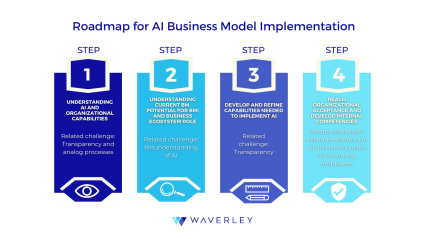
Overcoming Challenges
It’s very important to acknowledge the common roadblocks to building a successful AI strategy. For example, insufficient data, misalignment of strategy, etc. Realizing and preventing these challenges early is a must in your AI strategy planning.
Common challenges are:
- Insufficient data
AI models rely heavily on robust datasets, so insufficient access to relevant and high-quality data can undermine the strategy and the effectiveness of AI applications. - Lack of AI knowledge
A lack of awareness about AI’s capabilities and potential applications may lead to skepticism, resistance, or misinformed decision-making. This will drain any value from the strategy and block the successful integration of AI into the organization’s processes. - Misalignment of Strategy
If the AI initiatives are not closely tied to the organization’s goals, priorities, and vision, it may result in wasted efforts, a lack of support from leadership, and an inability to demonstrate meaningful value. - Scarcity of Talent
Professionals are needed to effectively develop, implement, and manage AI initiatives. A shortage of AI talent, such as data scientists or ML experts, or resistance from current employees to upskill, could impact the viability of the strategy.
Case Studies and Examples
Let’s check in detail the real-life examples of AI implementation in organizations.
| Messenger-Integrated Chat-Bot Based on NLP and GPT | AI-Powered Virtual Assistant for Ideation Sessions | R&D Project: AI-Enabled Interpretation of Electrocardiograms |
|---|---|---|
| Waverley Software created a smart chatbot based on generative AI that can be integrated into any messenger to assist users that will resemble human interaction using natural language. For our client in insurance, it helped to enhance the quoting process, create more personalized offers, and free up their personnel for other tasks. | Waverley Software has partnered with a company of thinkers and innovators to implement a new kind of virtual assistant that can turn the idea-creation process upside down. The company is using the tool to maximize the value of team brainstorming sessions, generate new ideas, and expand its business. | Waverley Software developed an innovative tool for annotation and interpretation of electrocardiograms. Compatible with various kinds of ECG this product integrates artificial intelligence and deep learning to streamline cardiac patient care, monitoring data, and diagnostics. |
Final thoughts
Even though artificial intelligence and machine learning open many doors for businesses in 2024, we believe that at this point we can not realize AI’s full potential just yet. For any company, the success of AI initiatives depends on many factors such as creating a well-designed AI strategic plan, coming up with approaches to implement this plan, and being aware of possible challenges. These are the key pillars of the AI integration process. Nowadays we can observe many cases of how AI benefits businesses and Waverley is doing what’s in our power to help streamline that technological revolution, working with companies and organizations worldwide as their AI transformation partner.
FAQ
What is the role of AI in business strategy?
AI in business strategy plays an important role. To be precise, AI takes a pivotal role in business strategy by enhancing decision-making processes, optimizing operations, and driving innovation. It helps businesses analyze data effectively, predict future trends, personalize customer experiences, automate tasks, and gain competitive advantages. An AI strategic plan will help to manage risks, support data-driven decisions, and foster innovations. AI implications for business strategy enable organizations to swiftly adapt to market changes and achieve sustainable growth.
How do we measure the success of our AI strategy?
Success in general is hard to determine, but the success of AI strategy for your business can be measured through key performance indicators (KPIs) aligned with business goals. Common metrics include accuracy and performance of AI models, business impacts such as revenue growth and cost reduction, operational efficiency gains, user engagement, and satisfaction levels, time-to-insight for decision-making, adoption rate and integration with existing systems, ROI and cost savings, compliance and risk management effectiveness, innovation outcomes, and feedback-driven iteration. We can track these metrics and evaluate the success of a company’s artificial intelligence strategy.
How can businesses ensure data privacy when implementing AI?
There are several steps to ensure data privacy while implementing AI. When you create a business with AI you need to consider the questions of data privacy very carefully. These steps include data encryption, anonymization, access controls, data minimization, transparency and consent, and regular audits and assessments.
What is AI’s business strategy?
AI business strategy means a plan that businesses adopt to leverage artificial intelligence technologies effectively. It involves identifying opportunities where AI can create value, defining clear objectives aligned with business goals, and implementing AI-driven initiatives to achieve those objectives. This plan aims to use the capabilities of AI to enhance operational efficiency, drive innovation, improve customer experiences, and gain competitive advantages in today’s digital landscape.
Revolutionize your business with an AI-driven strategy.


